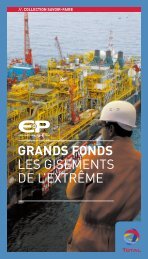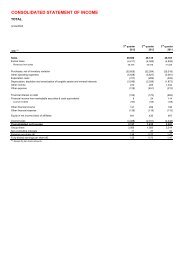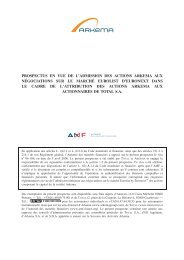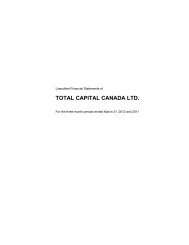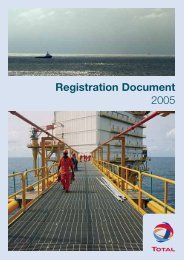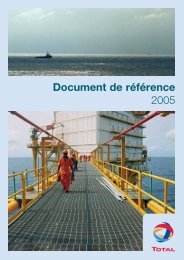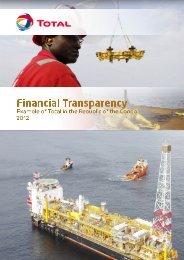Registration document 2007 - Total.com
Registration document 2007 - Total.com
Registration document 2007 - Total.com
You also want an ePaper? Increase the reach of your titles
YUMPU automatically turns print PDFs into web optimized ePapers that Google loves.
The Group has implemented strict policies and procedures to<br />
manage and monitor these market risks. These are based on an<br />
organization that separates supervisory functions from<br />
operational functions and on an integrated information system<br />
that enables real-time monitoring of trading activities.<br />
Limits on trading positions are approved by the Group’s<br />
Executive Committee and are monitored daily. To increase<br />
flexibility and encourage liquidity, hedging operations are<br />
performed with numerous independent operators, including other<br />
oil <strong>com</strong>panies, major energy producers and consumers and<br />
financial institutions. The Group has established counterparty<br />
limits and monitors amounts outstanding with each counterparty<br />
on an ongoing basis.<br />
Financial markets related risks<br />
As part of its financing and cash management activities, the<br />
Group uses derivative instruments to manage its exposure to<br />
changes in interest rates and foreign exchange rates. These<br />
instruments are principally interest rate and currency swaps.<br />
The Group may also use, on a less frequent basis, futures, caps,<br />
floors and options contracts. These operations and their<br />
accounting treatment are detailed in notes 1 paragraph M, 20<br />
and 27 to the consolidated financial statements.<br />
Risks relative to cash management activities and to interest rate<br />
and foreign exchange financial instruments are managed in<br />
accordance with rules set by the Group’s senior management.<br />
Liquidity positions and the management of financial instruments<br />
are centralized by the treasury/financing department, where they<br />
are managed by a group specialized in foreign exchange and<br />
interest rate market transactions. The cash monitoring and<br />
management group monitors limits and positions on a daily basis<br />
and reports results. This group also prepares marked-to-market<br />
valuations and, as necessary, performs sensitivity analysis.<br />
Currency exposure<br />
The Group seeks to minimize the currency exposure of each<br />
entity to its operating currency (primarily the euro, dollar, pound<br />
sterling, and Norwegian krone).<br />
Risk Factors<br />
Market risks<br />
For currency exposure generated by <strong>com</strong>mercial activity, the<br />
hedging of revenues and costs in foreign currencies is typically<br />
performed using currency operations on the spot market and in<br />
some cases on the forward market. The Group rarely hedges<br />
future cash flows, although it may use options to do so.<br />
With respect to currency exposure linked to non-current assets<br />
booked in a currency other than the euro, the Group has a policy<br />
of reducing the related currency exposure by financing these<br />
assets in the same currency.<br />
Net short-term currency exposure is periodically monitored<br />
against limits set by the Group’s senior management. This<br />
currency exposure is managed by the Group’s central treasury<br />
entities, which are responsible for debt issuances on the financial<br />
markets (the proceeds of which are then loaned to borrowing<br />
subsidiaries), cash centralization for Group <strong>com</strong>panies and cash<br />
management on the monetary markets.<br />
Short-term interest rate exposure and cash<br />
Cash balances, which are primarily <strong>com</strong>posed of euros and<br />
dollars, are managed according to the guidelines established by<br />
senior management (maintain maximum liquidity, optimize<br />
revenue from investments considering existing interest rate yield<br />
curves, and minimize the cost of borrowing) over a less than<br />
twelve-month horizon and on the basis of a daily interest rate<br />
benchmark, primarily through short-term interest rate swaps and<br />
short-term currency swaps, without modifying the currency<br />
exposure.<br />
Interest rate risk on non-current debt<br />
4<br />
The Group’s policy consists of incurring non-current debt<br />
primarily at a floating rate, or at a fixed rate depending on the<br />
level of interest rates, in dollars or in euros according to general<br />
corporate needs. Long-term interest rate and currency swaps<br />
can hedge debenture loans at their issuance in order to create a<br />
variable rate synthetic debt. In order to partially modify the<br />
interest rate structure of the long-term debt, TOTAL can also<br />
enter into long-term interest rate swaps.<br />
TOTAL – <strong>Registration</strong> Document 2006 77




